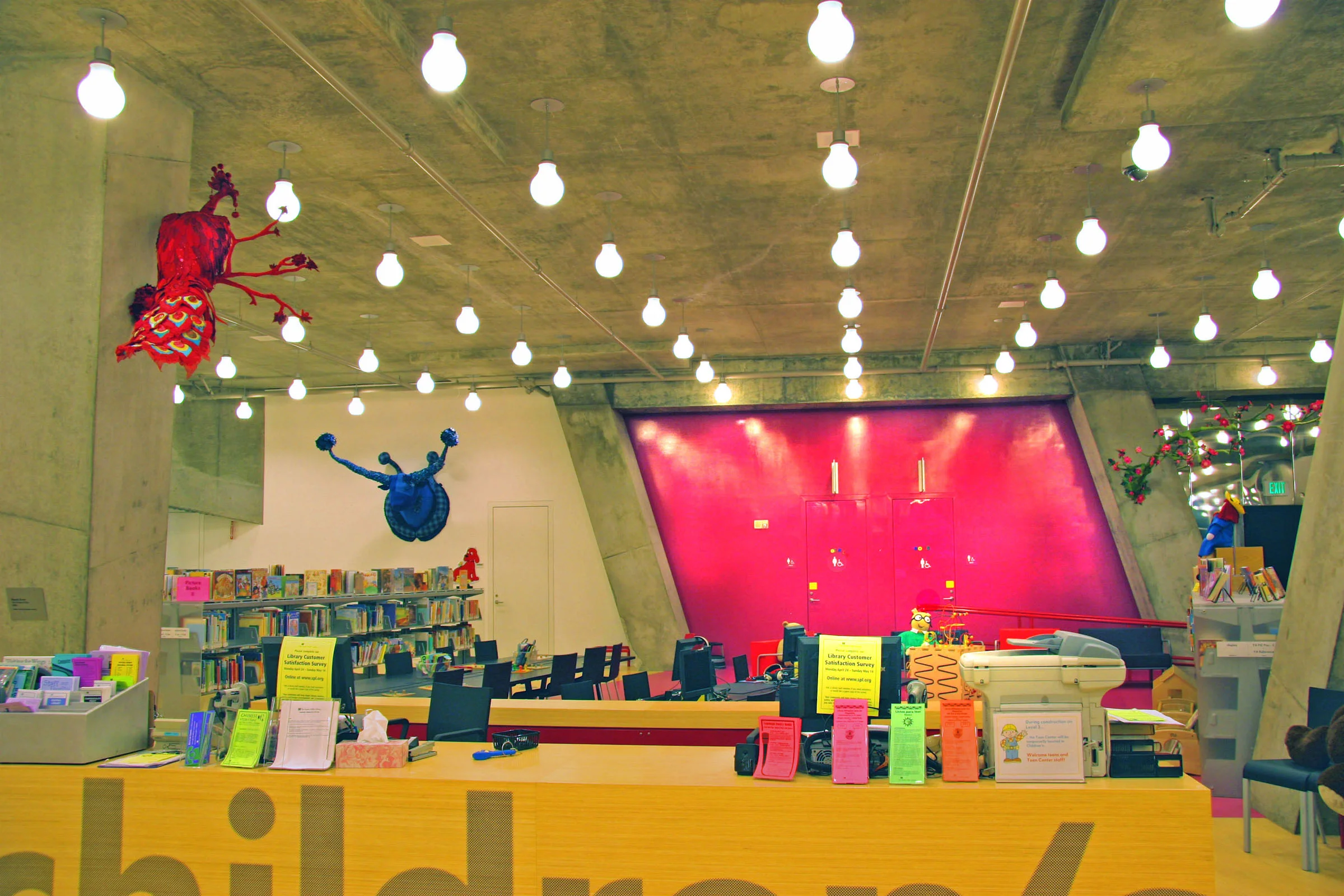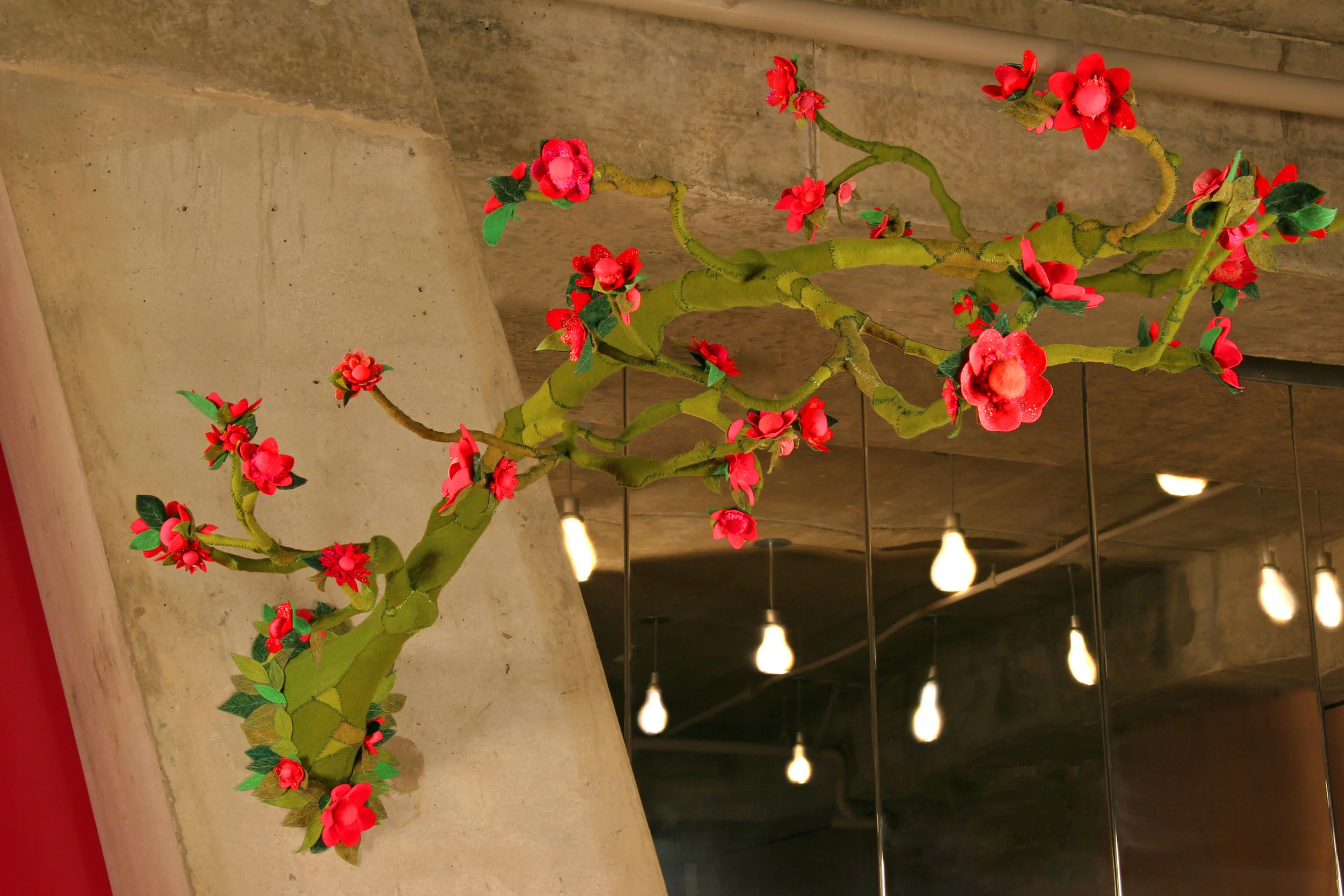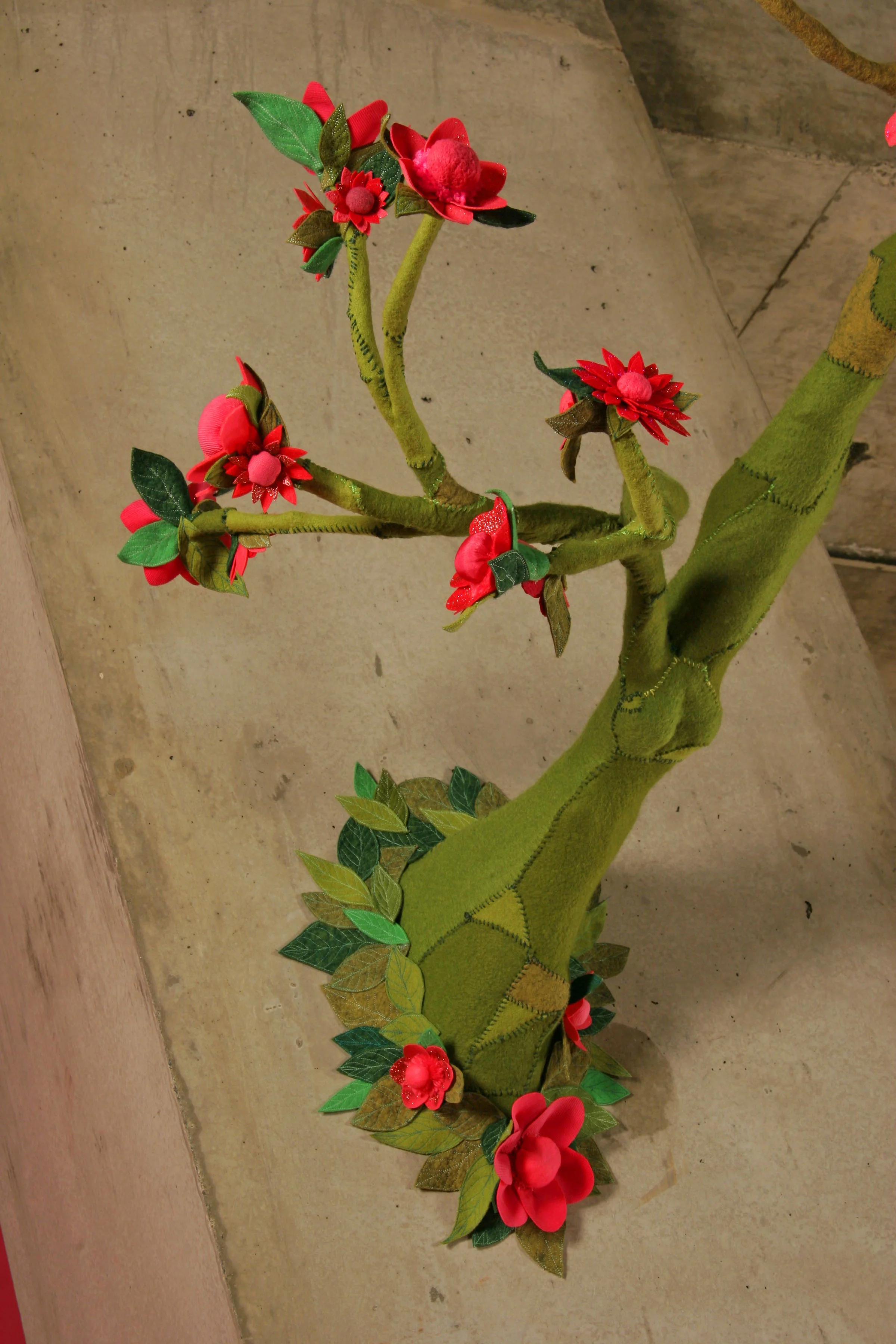











Seattle Central Library, designed by Rem Koolhaas
Permanent public installation, commissioned by The Seattle Office of Arts and Cultural Affairs, 2004-2005
The concept for “The Library Unbound” series asked that I probe the meaning of the library; its staff and patrons, its functions and collections. I chose to focus on the individual child patron who walks through the door with a seed -- an itch of an idea-- and the process that happens as they bounce back and forth through centuries, places, worlds far, near and non-existent to find what they did not even know they were looking for. The process is called research, but how often these moments of serendipitous discovery have re-shaped the direction of our lives.
I created work for the Children’s Center to honor the very first interactions we have with the library, as we learn it is a place for personal exploration. I endeavored to create work for the child that would appeal to their natural intelligence by being elegant, thought-provoking, exciting, mysterious. I wanted to create work that was, at once, about research as well as a product of it.
Each piece serves as a metaphor for a different idea of research. Research, the dry dull word, is really a disguise for what compels us to know more; our life’s work, our calling, our passion. For The Phoenix Fairy, it is the metaphor of the continual rebirth of knowledge while at the same time staying constant. For Babe, the metaphor is that history is a past that rests just below the surface of things, rich discovery waiting to happen if we just investigate what resides around us. For The Magical Grove, the metaphor is the expansion of a seed of an idea planted within us into the ongoing flourishing of our life.
As an artist, my work has often dealt with narrative and story, but this has been my first venture into inspiration from actual texts. Each sculpture has been inspired by a suite of books, all from the Folklore section.

Babe
There is always history where ever we go, waiting to be discovered and rediscovered. This is the concept I want to convey to the children of Seattle with Babe, a large glitteringly beautiful portrait bust of the Blue Ox. I had a dim understanding, like many transplants to the area, that Seattle was built on the logging industry. But knew little more than that. What I discovered, from the resources at the library, is that there is a rich connection between the logging history of the US, the creation and recording of Paul Bunyan folklore and the Pacific Northwest, namely, Seattle. I see the Ox, quietly looming above the stacks like an oracle, as if observing the activity, reminding children that the library can bring us to a better understanding of our own surroundings, and the history of it just below the surface.
Back when Seattle was the deep woods, a unique oral tradition was continuing to grow, one brought here by the migrating loggers as they made their way from Maine to Michigan, Wisconsin, Minnesota and then to the Pacific Northwest. The Paul Bunyan legends weren't originally intended to please children, but rather to entertain and distract the roughest of men from incredible hardships and an extremely dangerous way of life.
Paul Bunyan was a hero to people who were cut off from larger society, perhaps immigrants, who needed to feel they possessed extraordinary abilities, courage and where a part of something great. As loggers moved from camp to camp, the unique quality of that camp's stories would go with him, be retold and mixed with the flavor of the new camp. This is how we have stories about the Puget Sound that seem vaguely familiar to the ones about the Lake States.
In his book published in 1947, Seattle historian James Stevens calls the stories “the art of the plain American”, a highly imaginative, inventive and outlandish creative output by people who mostly were not extensively schooled and many most likely could not read. Stevens writes “ thousands of unknown narrators ... contributed to this legend and, today, our understanding of that time as they saw it, not what was written down by people outside of the camps. “ For the children of today, these outlandish and preposterous stories can function as a primary source, a clear view right though Babe's eyes to the way it was.
I chose to be inspired more by the nature of the past than by the Big Men. In the story of Babe's birth, we see an introspective, intimate vision of Paul, but we also see the stunning beauty of Babe. And this is where my vision of the Ox comes from.

“The drifts of the beautiful unnatural snow melted away in streams of blue water, and the marvelous color of this historic winter vanished, but the glittering blue of Be`be`'s silken hair remained. His tail brush was of a darker blue; it looked like a heavily foliaged cypress bough in purple twilight; and Be`be` was proud of this wonderful tail brush that belonged to him, for he would twist it from behind him and turn his head and stare at it by the hour” -- James Stevens “The Winter of the Blue Snow”

The Phoenix Fairy
The body of ideas and imagery about the Phoenix arches across mythology, astrology, astronomy, world religions, animal behavior, history and children's literature. There are so many different interpretations of her, but in essence, she is a symbol of renewal, of resilience (because of her trial by fire), and of immortality. This desire for immortality spans across nearly every religious tradition, and is a persistent human fixation in one form or another.
But the Phoenix illustrates a particular view of immortality. The corporeal body of the bird ages; she becomes haggard, world weary and foresees her death. Reborn from her own ashes, she is the same bird, but also a different bird , a new bird. Hers is not a life of static sameness but is reborn at every age. Early on, while discussing my ideas about this image with the children's librarians, one made an analogy between the Phoenix and the Central library, how the new building is a rebirth of the library – re-invisioned concepts, new body, but its core purpose the same. Its store of wisdom and knowledge remains. It even emerges from the site of the old, for the third time. I'd like to extend this analogy to Knowledge itself; continually reinvented as it stays the same . Human inquiry seems always in a state of re-discovery of what has passed as well as innovation unimagined before.
As an emblem of children’s guide through the library, the Phoenix Fairy rests in the rafters close to the literal stewards of the children's section; perched above the librarians' information desk, the red of her feathers picks up the red of their desk, as well as the red of the information centers throughout the library.

The Magic Grove
Over and over again in children's books and in the child imagination, the outside grows in. It's a persistent dream that, I daresay, lasts into adulthood. In childhood, we are given and invent images, and seem to accept more readily the possibility that animals can converse with us, trees are a willing participant in our lives, and anything we can imagine might actually happen. Perhaps the quintessential example of this willingness to allow the outside to come in, and by doing so, allow the inside to come out, is when Max in Where the Wild Things Are begins to watch his bedroom fade into a jungle, grass pokes up from the carpet, trees appear in the corner , and he is ruler of his imagination. As I talked to children and adults about their favorite books, over and over I was told about this moment in the book, as I do remember its potent effect from my own childhood.
There are at least 200 books in the children's section that have trees as their main character, representing an equally large variety of cultural traditions and symbolic meanings. The symbol of the tree can mean bountiful growth, fertility, sustenance as it feeds both our body and our mind. The tree can embody family, home, protection, with a root system anchored firmly to a place while the branches continue to extend ever outward. They are elders in our tribes, entire eco-systems, circulators of energy. As a human community, we are beguiled by the symbiotic relationship we have with these organisms. The Magic Grove is inspired both by a Persian Folktale, and an image in my mind of what it might look like if every one of those 200+ tree books literally began to grow, the Children’s Center truly would be a magic grove.